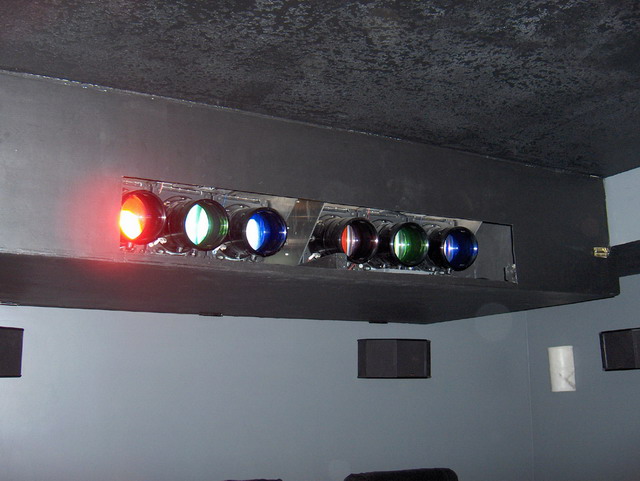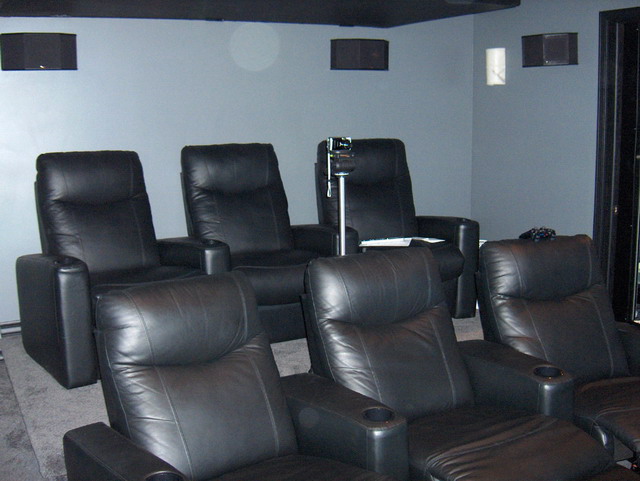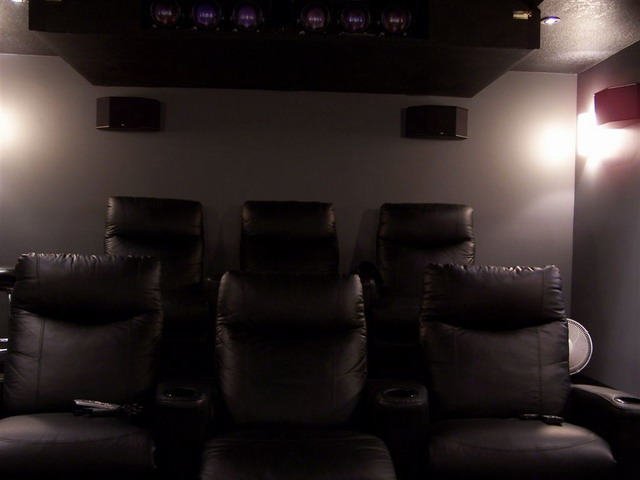I thought I’d post this write-up dissecting a
well thought out home theater that I recently
visited in the Chicago area, as it’s one of the
best home theaters I’ve been witness to. The
video system consists of two stacked
Sony G90 9”
projectors. Stacking is an application of two
projectors where both projectors are projecting
the same image on the same screen, thus doubling
the brightness of the image. The projectors of
course must be very accurately aligned so that
the images are exactly on top of each other.
The G90s are driven by a
DVDO VP50 scaler,
and sources include a Toshiba A1 HD-DVD player,
an Xbox360, a JVC 5U DVHS machine, a Sony PS3 as
BluRay player, and an HTPC. Everything but the
Xbox360 is fed via HDMI to an NEC ISS 6020 via a
Moome HDMI card with gamma correction.
The audio receiver is a Sony Sony 4ES 7.1
Receiver with true 110 watts per channel. All
main speakers are being driven with the amps in
the receiver, the 2
SVS PB12 Plus/2 Subwoofers
are self powered.
The speakers are
Klipsch KLF-30 fronts with
matching center channel and 4 Klipsch RS-45
Surrounds (wired for 7.1 surround). The screen
is a custom built 10’ wide 16:9 ratio
SMX, which
is acoustically transparent. The L-C-R speakers
are located behind the screen in a separate area
fully accessible for tuning and maintenance.
This system excels in performance in my
opinion, and is based primarily on how the room
is laid out and set up, and this is what I want
to concentrate on here.
Some pictures:
Here’s a back view of the theater. The
Klipsch surround speakers can be seen, and the
two G90s are built into a ventilated enclosed
housing. The rear row of seats are right under
the projectors, which are for all purposes
silent to the viewer. The brass coloured latch on
the far right side of the image (and one on the
left side) allow the bottom cover to be flipped
down for projector maintenance if ever required.

You can’t have a theater without comfy seats.
6 seats in this theater all feature the ability
to recline, and have the mandatory drink holder
in each armrest. The walls are painted a
gray/blue, while the ceiling is a textured matte
dark gray to minimize light reflections.
Similarly, the carpet is a dark gray as well.

The front of the room: The SMX screen is a
whopping 10’ wide, which the stacked G90s handle
with ease. The ceiling directly in front of the
screen is covered with a matte black velvet to
prevent light reflections. This small detail
makes a BIG difference in the image, and had I
not seen the ‘before and after’ effect (I was
there while the velvet was installed), I would
have never guessed that the extra light
absorbing qualities of the velvet would make
that much of a difference! The IR sensor that
runs the remote commands to the equipment rack
is located in a slot in the valance above the
screen.

The narrow room behind the screen, showing
the speakers and subwoofers behind the screen.

A look towards the back of the room, standing at the screen. The
rear seating is raised so that everyone gets a good look at the
image. The surround speakers are dipolar for the best surround
imaging, and are mounted on the wall above the listener’s ears.
This is the ideal location for surround speakers. Less imaging
is experienced if the speakers are lower or if they are mounted
flush in the ceiling firing down.


|






